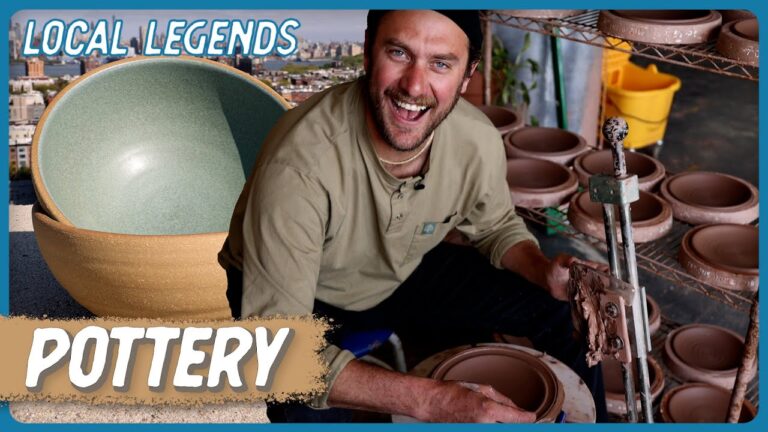Have you ever wondered about the intricate process behind kiln firing ceramics? From the precise temperature control to the chemical transformations that occur, the science behind kiln firing is a fascinating blend of art and chemistry. In this article, we will delve into the intricacies of kiln firing, uncovering the secrets behind creating durable and beautiful ceramic pieces. Join us on this journey as we explore the science behind this ancient technique.
What is the scientific explanation for firing pottery?
The science behind firing pottery lies in the transformation of clay into metakaolin through a process of heating. As the clay reaches temperatures of 1832°F (1000°C), its crystals start to break down and melt. This melting process continues until needle-shaped crystals of mullite 3Al2O3•2SiO2 begin to form at 1922°F (1050°C), providing the fired clay with strength and hardness. Additionally, this transformation releases extra free silica, further contributing to the properties of the pottery.
In summary, the firing of pottery involves the metamorphosis of clay into metakaolin, which undergoes a series of changes as it is heated. These changes result in the formation of mullite crystals, ultimately giving the pottery its durability and strength. Understanding this scientific process is crucial for creating high-quality and long-lasting ceramic pieces.
How does a kiln work for ceramics?
A kiln, constructed from refractory materials, is where a ceramist places their pottery for firing. The heat generated in the chamber or nearby firebox gradually rises to high temperatures, allowing the ceramic ware to undergo the necessary firing and cooling process.
Is the firing of clay in a kiln considered a chemical change?
Firing clay in a kiln involves several chemical changes. Aside from the physical transformation of the clay into a hardened ceramic, there are other chemical reactions taking place. This includes the burning off of organic matter present in the clay, the decomposition of carbonates found in glazes, and the further crosslinking of metakaolinite to form a three-dimensional network while eliminating water.
These chemical changes are essential in the transformation of raw clay into a durable ceramic material. The firing process not only hardens the clay, but also ensures that all organic impurities are removed, and the glazes undergo necessary chemical reactions. Overall, firing clay in a kiln is indeed a chemical change, as it involves multiple reactions that result in a permanent alteration of the clay’s composition.
Mastering the Art of Kiln Firing Ceramics
Mastering the art of kiln firing ceramics requires a delicate balance of timing, temperature, and technique. From loading the kiln with precision to controlling the firing process, each step plays a crucial role in achieving the desired results. Understanding the science behind the transformation of clay into durable, beautiful pottery is key to mastering this ancient craft. With practice and patience, artists can harness the power of the kiln to create stunning pieces that showcase their skill and creativity.
Exploring the Secrets Behind Kiln Firing Ceramics
Have you ever wondered about the intricate process of kiln firing ceramics? It’s a fascinating journey that transforms raw clay into beautiful, durable pieces of art. The first step involves shaping the clay into the desired form, whether it’s a delicate vase or a sturdy plate. Then, the pieces are carefully loaded into the kiln, where they undergo a series of temperature changes that ultimately result in a stunning, finished product. Exploring the secrets behind kiln firing ceramics unveils the precision and patience required to create these timeless works of art.
The key to successful kiln firing lies in understanding the intricate balance of time, temperature, and airflow. Each stage of the firing process plays a crucial role in determining the final outcome of the ceramic piece. From the initial bisque firing to the final glaze firing, artisans carefully monitor the kiln to ensure that the pieces are exposed to just the right amount of heat and oxygen. This meticulous attention to detail is what sets kiln-fired ceramics apart, showcasing the dedication and skill of the craftsmen behind the art.
Delving into the secrets behind kiln firing ceramics opens up a world of creativity and innovation. Artists continually push the boundaries of traditional techniques, experimenting with different firing schedules and glaze combinations to achieve unique and captivating results. Whether it’s a classic, earthy finish or a bold, modern design, kiln firing allows for endless possibilities in creating one-of-a-kind ceramic masterpieces.
A Comprehensive Guide to Kiln Firing Ceramics
Embark on a journey through the intricate world of kiln firing ceramics with our comprehensive guide. From the basics of clay preparation to the intricate process of glazing, this guide covers everything you need to know to create stunning ceramic pieces. Learn about the different types of kilns, firing techniques, and temperature control to achieve the perfect results every time. Whether you’re a beginner or a seasoned ceramic artist, this guide will provide you with the knowledge and skills to take your pottery to the next level.
Delve into the art of kiln firing ceramics and unlock your creativity with our step-by-step instructions and expert tips. Discover the science behind the firing process and how to troubleshoot common issues to ensure a successful outcome. With detailed explanations and visual aids, you’ll be able to confidently navigate the world of kiln firing and bring your ceramic creations to life. Let this guide be your go-to resource for all things kiln firing, and watch as your pottery skills flourish and your artistic vision comes to fruition.
In summary, kiln firing ceramics is a fascinating process that combines artistry with science to create beautiful and durable pieces. By understanding the intricate relationship between temperature, time, and atmosphere within the kiln, artists can achieve the desired results and bring their creations to life. With careful experimentation and attention to detail, the possibilities for creating unique and stunning ceramic pieces are endless.



